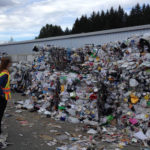Why are Recycled Products More Expensive?

Why are Recycled Products More Expensive?

You may have noticed that sustainable and eco-friendly goods are frequently higher priced than the less sustainable versions. Recycled products are no exception. This may be surprising since recycled products are made from materials that were thrown out and so it seems like the materials costs should be less. So why are recycled products more expensive?
An example:
If you go to buy printer paper at Target, right now they are listing a ream of their UP&UP brand 8.5 x 11 inch copier paper at $4.49 a ream (500 sheets). The 100% recycled version of the same brand costs $8.19. That’s almost twice as much, making it cost prohibitive for many people to buy. Why the cost difference?
There are multiple reasons why a recycled product may cost more than one that contains no recycled content.
Recycling is labor and energy intensive.
Let’s take a plastic cup as an example. For a plastic cup to be made from recycled plastics, that discarded plastic has to be picked up at your home or business, trucked to a Materials Recovery Facility (MRF, aka the recycling sorting center), sorted out from the metal, paper, glass and other plastic types, baled, shipped to a plastics recycler where it is shredded, cleaned, melted down and processed into sheets or pellets, then shipped again to the final manufacturer who will make it into new products. This is actually far more work than simply taking petroleum and processing it into virgin plastic.
The recycling process is inefficient and dirty.
Part of the reason that getting materials through the whole recycling process is so complicated has to do with the fact that many Americans don’t understand their local recycling rules and throw all kinds of stuff in that shouldn’t be there. This leads to contaminated materials at the other end, so trying to clean it and make it useable is difficult and requires extra energy and work.
Plus, a few years back many recycling programs switched to single-stream, or commingled recycling. This means that everything is thrown together in one curbside bin, rather than you having to separate glass, plastic, paper and metal into separate containers. Single-stream recycling increases participation in communities, but it also leads to more contamination and a more complicated process for sorting all that stuff out.
The upshot – Taking (for instance) dirty used paper products and trying to clean all the grease, food, ink, plastic coatings and other contaminants from it to get to the clean paper fibers so that they can be made into new paper products can end up being more work than simply making paper from virgin wood. That extra work leads to extra cost.
There is an increasing demand for recycled goods.
Businesses know that there is a demand for greener products and that many consumers are willing to pay extra for sustainable products. Some companies may be charging more for recycled simply because they can.
There are exceptions.
Metal is actually pretty valuable, since mining for raw metals can be an intense, difficult (and dirty) process. And metal is relatively easy to sort out from other materials using magnets (for steel) and Eddy Current magnets (for aluminum). Plus, a material like aluminum also doesn’t degrade at all during the recycling process (unlike paper and plastic) and can be recycled indefinitely, so recycled aluminum can be very cost competitive or even cheaper than virgin aluminum.
What would bring the price of recycled products down?
There may be an argument for returning to multi-stream recycling rather than the current system of throwing everything in together, but most communities have invested heavily in single-stream, so I think that’s unlikely. Which means the recycling process needs to become more efficient through improved technologies and Americans need to be better educated about what to throw in their bin and what not to.
More competition would likely help as well. There currently aren’t a ton of options for recycled products. Hopefully increasing demand will encourage more businesses to jump on the recycled products bandwagon. If recycled products had to compete on the shelves with several other recycled versions, that could help bring the cost down.
State-enacted bottle bills would improve glass reuse and recycling.
But what it will probably take is regulations requiring minimum recycled content on products and also regulations that hold manufacturers responsible for the costs associated with the disposal of their packaging. These costs are currently borne by local communities and taxpayers, so manufacturers have no incentive to create products that can be reused or recycled. They could be incentivized to package products in reusable or more easily-recycled materials.
For answers to more recycling questions and info on how to recycle common items, visit the Master Recycling Guide!






